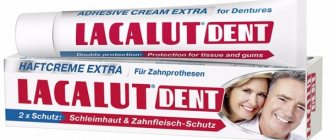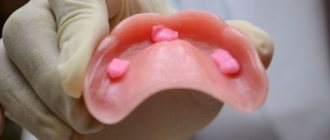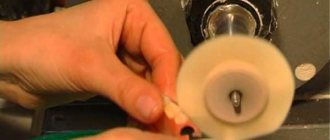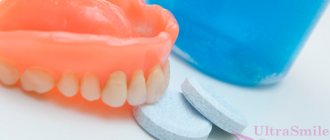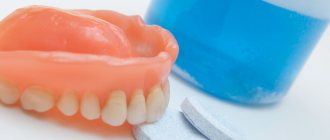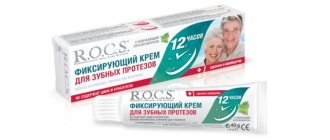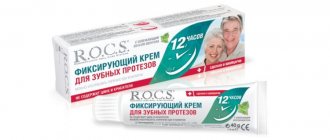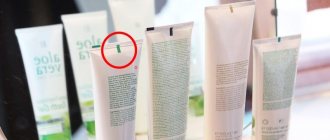The most common service in dentistry is prosthetics. If the dentist performs it correctly, a person’s teeth will become straight and their smile will be attractive. Since a large load is created on the jaw during chewing, situations may occur in which structural elements are damaged. You need to figure out how to fix a denture at home without resorting to the services of a dentist.
When to repair a structure
The materials in dentures are highly durable, but over time they can wear out or even break. Many people who use a prosthesis every day experience damage that requires emergency repairs.
There are the following reasons why device correction may be required:
- the crowns acquire a defective shade, for example, yellow or brown;
- the appearance of discomfort, pain, which previously did not bother the patient when using the structure;
- detachment, crack, puncture, peeling or other defects causing discomfort or loss of function;
- mechanical damage when clenching teeth, chewing hard elements.
If a breakdown occurs, it is better to contact your dentist directly so that he can repair the product without causing further defects. But there are times when immediate contact with a specialist is impossible. For example, if a person is away. Then temporary repairs can be done at home.
It is important not to damage the structure yourself, since repairing it will cost much less than buying a new prosthesis. There may also be breakdowns that a person cannot handle, for example, if repairs require the use of specific medical instruments.
Damaging factors
The use of dentures is very convenient for people who have lost part of their teeth or the entire dentition. This is a life-saving design, thanks to which the chewing function is fully restored. If it is installed in a timely manner, there will be no defect in the soft tissues or jaw bones. After installation, the dentist warns about the following features:
- rules of daily care;
- possible types of defects for which you will need to seek help from a dentist;
- rules for installing and removing the structure.
A small defect or complete breakdown of a denture can happen at the most inopportune moment. this :
- end of service life;
- impact on various objects, hard surfaces, which occurs when removing or installing a prosthesis;
- improper manufacturing of the system, use of low-quality materials;
- the appearance of bubbles that remain between the prosthesis and the person’s own tissues makes it difficult to use the prosthesis.
If a denture breaks, the patient may not notice it and will continue to use it. This may lead to the following consequences:
- damage to a person’s own tissues, for example, if a chip appears on the prosthesis;
- worsening defects on the prosthesis, for example, a small crack can lead to a complete split of the structure.
Both part of the structure and the entire product may break. It all depends on the extent of the damage. It is necessary to quickly make a decision on the repair method in order to prevent complications and maintain the integrity of the structure.
Fixation of dentures
Powder
Pros:
- can be worn with normal or reduced salivation;
- does not change the taste of food and drinks;
- inexpensive.
Minuses:
- it is very difficult to apply the powder evenly;
- Before using the powder, the surface must be moistened;
- After application, you must wait a few minutes for the composition to swell and securely fix.
Gel
Pros:
- holds the prosthesis well;
- safe because it does not contain dyes;
- not sensitive to cold or hot food.
Minuses:
- high price;
- restriction on hot food and drinks;
- high consumption due to the liquid consistency of the gel;
- It does not fix dentures for long, so it must be constantly applied.
Cream
Pros:
- permanently fixes the prosthesis;
- safe, because it contains no toxic substances;
- has a thick consistency, and therefore a small amount is enough for good fixation;
- most often has auxiliary components that provide fresh breath.
Minuses:
- Do not allow the product to come into contact with the mucous membrane - this can lead to irritation;
- After fixation, you need to wait 15 minutes, do not eat or drink.
Spacers for fixing dentures
Pros:
- getting used to the design occurs much faster;
- can be combined with the use of other fixing agents;
- does not affect the height of the bite;
- can be used in the presence of dental deformation;
- safe and universal remedy.
Minuses:
- it costs expensive;
- An allergy may develop to the components of the pads.
Glue
Pros:
- quick adaptation to the design, can be used for temporary prostheses;
- can be used for stroke, dry mouth and neurological pathologies;
- provides fresh breath.
Minuses:
- irritation of the mucous membrane;
- With improper hygiene, the development of pathogenic flora can occur.
Recovery Features
Many people are afraid to go to the dentist when defects appear, because they believe that repairs will be expensive. But it is better to repair a small defect in a timely manner than to completely replace the structure. Features of the restoration of the product depend on the cause of the damage and the degree of development of the defects. The recovery method takes place in stages:
- Removal and inspection of the structure
. If there are particles of dirt on the surface, the structure is completely cleaned. - Uses of Dental Resin
. Damaged particles stick together to create a sealed state. You can achieve an appearance that does not differ from the original quality. - Evaluation of the shade of the structure
. Its color is affected by drinking caffeine and strong tea, and smoking cigarettes. If contamination is detected, the surface must be cleaned. This should only be done by a dentist using specialized medical solutions. He will achieve the original, ideal shade of the crowns. - Chips of a small part or the entire crown
. There is no need to worry about this; even if a large part of the column breaks off, it can be restored. For this purpose, they turn to a dental technician to strengthen the broken product into place.
If a piece breaks off from a denture, you should not throw it away. Together with him, they contact a dentist or dental technician, he will help restore the integrity of the structure.
Situation No. 1: there are problems with the appearance and shape of the crown
Nature of defects
As a rule, the integrity of the outer covering of the crowns is compromised. Unsightly chips, small scratches and cracks appear on them. Some patients also complain of the structures changing color from white to yellow.
The photo shows a chipped crown
How the problem is solved
If chips and cracks occur, it is possible to repair the denture directly in the patient’s mouth. The doctor can restore the beauty and integrity of the crown using composite materials and photopolymers. Moreover, this can be easily done both with a broken piece of the crown (then it is glued in place) and without it. As for changing the shade of artificial restorations, this cannot be done by bleaching or other procedures. You can only exchange an old product for a new one if this is a very important issue for the patient.
To prevent the restorations from changing color, immediately after their installation, carefully monitor your oral hygiene, stop smoking and drinking too bright foods and drinks (for example, beets, red wine). Or initially choose crowns from materials that are least amenable to staining, for example, zirconium dioxide. And be sure to do professional hygiene 1-2 times a year.
For such problems, in most cases the crown will not need to be removed. However, if an inflammatory process has developed underneath it (caries, periodontitis, periostitis), then you will have to dismantle the structure to get to the root canals, where the infection usually “sits”, and after treatment, make and install a new one.
Bonding materials
In the process of creating a crown, only materials with a high degree of strength are used. But even in this case, small chips and cracks are possible. You can eliminate them yourself. But it is important to understand that home renovations are only a temporary measure. As soon as the patient has the time and opportunity, he should see a dentist.
If repairs are initially carried out at home, dentists give the following recommendations:
- Preheat the device to allow the wax to melt. This technique is typical only for removable structures, so as not to damage a person’s own tissue.
- Giving the correct shape to the gypsum base. It should be cone-shaped. To change the shape, the prosthesis is repeatedly exposed to heat.
- When the device has cooled, the gluing area is treated with sandpaper so that there are no rusty particles left on the surface that scratch the gums.
- Fastening the fallen part of the crown to the structure. It is important to place it in the exact location, not to mix it up, otherwise severe discomfort will occur.
- Bonding the crowns and the base of the structure using wax or other auxiliary material. The glue must be reliable, but safe, it must not damage the device.
- Wait for the structure to dry and cool. The adhesive substance should not get on the soft tissues in the person’s mouth. The remaining excess wax that has spread around the edges is removed.
Bonding may require more than just wax. To achieve a more stable fixation, it is recommended to purchase special glue from a dental store. It is intended specifically for dentures. Once glued, the device can be reused, but it is important to understand that this will not last long. The structure glued in this way can be damaged again, so it is important to consult a doctor in a timely manner. It is unacceptable to further damage the system during repairs, otherwise restoration of integrity by the dentist may not occur.
Possible consequences
The longer a patient uses a prosthesis characterized by an unstable position, the more serious the consequences for his health may be. Potential complications include:
- Constant physical and psychological discomfort associated with displacement of the structure while eating or communicating with others;
- Damage to the oral mucosa caused by rubbing or biting;
- Impaired diction, as well as distortion of natural facial proportions;
- Regular entry of food particles into the area between the prosthesis and the base, which results not only in the formation of pathogenic microflora, but also in disorder of the digestive system;
- Possibility of failure of the replacement structure;
- The need for constant adjustment of the position of the removable denture.
In such a condition, it is difficult to talk about restoring the aesthetics and functionality of the jaw, therefore, at the first signs of a fixation disorder, it is recommended to contact your dentist.
Removable denture repair
To carry out the repair procedure yourself requires skill and a little experience. The patient must decide whether he can eliminate the defect on his own, or whether it is better to go straight to the dentist. There are certain risks in the process of such actions:
- greater damage to the device;
- improper repair leading to malocclusion;
- the presence of chips and rough surfaces that cause damage to adjacent soft tissues.
If you repair the product yourself, you may not be able to fully restore its functionality.
If you contact a professional dentist and dental technician in a timely manner, the product can be completely repaired in a few days and its functions will be restored. The integrity of the structure is restored in full. To do this, dentists follow step-by-step instructions in restoring the integrity of the prosthesis using medical equipment.
Repair instructions for plate dentures:
- Detection of a defect, application of the damaged structure to the location. Fixation is carried out using sticky wax or medical glue.
- Application of an insulating agent. It is installed from the side of the prosthetic bed. This prevents the plastic structure and plaster from sticking together. You cannot do this with your hands; use a brush or brush.
- Formation of a fixing model from plaster. Only top class materials are used. The denture needs to be divided and the fracture lines processed with a micromotor or cutter. Individual parts of the structure are installed using a fixing model. The dentist ensures that the distance between the fixation models in the area of the fracture does not exceed 3 mm.
- Forming a fold. The bevel angle should be 45° in relation to the base of the device. This will create a smooth transition between the old and new areas of plastic. They will be connected in a better shape.
- Application of an insulating agent. It is used on the surface of plaster so that the adhesive material does not absorb liquids spreading from plastics. Otherwise, large pores will form. As soon as the parts of the prosthesis have been fixed with monomer, they begin to knead the plastic. This action occurs in stages.
- The plastic prepared according to plan should swell. It is transferred to the prosthetic areas with a reserve. Then press a little with your fingers. The resulting product is transferred to the apparatus to polymerize the plastic.
At the final stage, excess plastic must be removed. For this purpose, a micromotor and a press are used. The surface is leveled with medical instruments intended for grinding. After polishing the surface, the product is treated with antiseptic solutions. It is ready to use.
Recovery technique in the clinic
At the dental clinic, the doctor initially examines the device visually. It should be examined by a dental technician. If pieces of food and other foreign objects are stuck in the denture, pre-clean it. Only after this can you accurately see all the defects and begin the restoration of the structure. If you exclude the cleaning step, the adhesive will not be able to completely fix the broken product. Then the repair procedure will be ineffective. Only after cleaning can high-quality sealing be achieved.
If the defects in the device are excessively large, the dentist will recommend completely replacing the structure. This is due to the following features:
- saving money, since repairs may require similar financial resources as major repairs;
- the possibility of a lack of quality effect during repairs; the base will continue to break, damage tissues, and disrupt the bite.
Only if minor chips or cracks appear on the prosthesis, it can be restored. For example, if a small chip occurs on the crowns, remove the device and fix it. Why install the crown in place? The result should be a product that is not inferior in function to new prostheses.
Many patients believe that they can handle the repair themselves. But there is a big difference between home bonding and professional services. At home, you can make a little adjustment to the design before going to the dentist. Complete repairs can only be carried out by a competent dental technician. He must have specialized tools at hand in order to carry out high-quality restoration.
The patient does not have solutions or tools at home that will return the whiteness to the crowns on the prosthesis. Periodically, it is necessary to restore the shade in order for the prosthesis to perform an aesthetic function. It should completely replace the appearance of real teeth.
It is not always possible to achieve high-quality restoration after repair, even from a dentist. For example, if a stamped device or a product without metal is damaged, it cannot be repaired.
Complete dentures
If there are no teeth left in the jaw at all, removable dentures can also be used to restore chewing function. They are fixed in fundamentally different ways. For example, the structure can be held in the oral cavity without additional fastenings due to the fact that:
- adhesion occurs between surfaces under the influence of natural adhesion, which is provided by a layer of salivary fluid between them;
- protruding alveolar processes of the jaws limit the movement of the prosthesis in the oral cavity;
- the system of valves and suction cups promotes more dense adhesion of the structure to the surfaces of the mucous membranes.
A more reliable method of fixing a complete denture is to install it on implants. Their number can be minimal - from two to six, depending on the clinical situation. With significant atrophy of the alveolar process, this method helps to stabilize the structure in the jaw, securely securing it to metal mini-supports. Fixing a complete denture on implants allows people with edentia to regain their quality of life to the fullest extent possible after losing teeth.
Repair price
The cost of restoring the quality of a denture after repair depends on the following factors:
- the complexity of the work performed by a dental technician;
- product material;
- area and degree of damage.
For example, if a patient’s metal-ceramic structure is slightly broken, repairs can reach up to 2,000 rubles.
The following approximate price list is highlighted:
- installation of a new artificial crown - 2500 rubles;
- professional cleaning and whitening of crowns, basics of the device - 1000 rubles;
- restoration of crown shade when drinking coffee, after prolonged smoking - 1200 rubles.
If you carry out the restoration yourself, the price will be significantly lower, but the entire structure will not be able to regain its original appearance. The damage may recur or continue to get worse.
